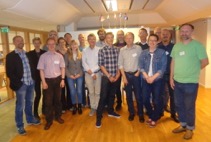New ideas to develop e-infrastructure for Nordic biodiversity
On 26/27 August 2015, biodiversity researchers and service developers gathered in Oslo to present scientific use cases and to discuss opportunities for Nordic collaboration on advancing e-Infrastructure and its use beyond what is possible at the national level.

The first day was dedicated to short presentations highlighting the state of the art in various applications of biodiversity research. Every presenter prepared a set of key challenges/opportunities whose successful solution requires collaboration across borders. The second day kicked off with intensive group work to envision joint efforts and services, and to break them down into practical activities. Four groups independently developed forward-looking ideas combining the strengths of national initiatives to enable new science, to share implementation costs and to better support the adoption of existing services.
The findings were summarized into three major categories:
- establishing a secretariat within the community for coordinating joint activities on e-Infrastructure and aligning national policies
- pooling expert knowledge in a virtual support center for Nordic biodiversity
- integrating data sources into a Nordic Analysis Portal, thereby allowing easier sharing of data and enabling new science through commonly developed analysis tools.
The participants agreed to develop concrete activities to implement their vision of a competitive Nordic e-Infrastructure for biodiversity informatics, and to initiate a collaborative project between NeIC, the national e-Infrastructure providers and the Nordic biodiversity community.
“We look forward to form a tight and fruitful cooperation where the Nordic countries pool its resources and complement each other with its respective skills,” says Ulf Gärdenfors, managing director of the Swedish LifeWatch.
“The synergies of aligning the national efforts of Iceland, Finland, Denmark, Sweden and Norway will undoubtedly gain the Nordic biodiversity informatics community in terms of reduced costs, increased efficiency and improved quality of future eScience developments,” adds Frank Hanssen, coordinator of the Nordic LifeWatch project.
